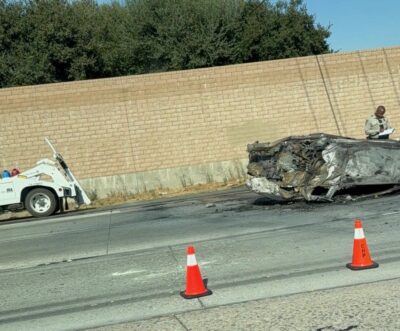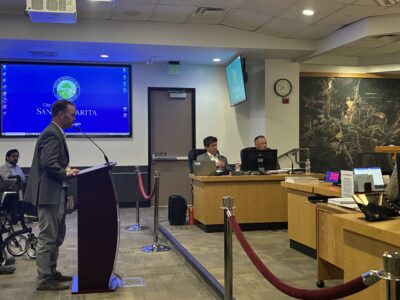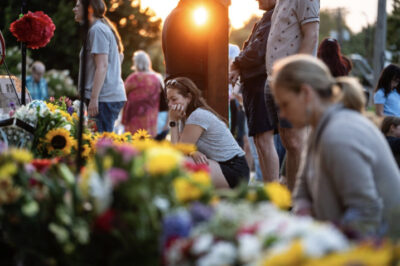Holocaust survivor Joe Alexander gave a presentation on his life and experiences surviving 12 different concentration camps at Hart High School on Sunday evening.
“Tonight, Santa Clarita will have the opportunity to hear from a man who has survived these atrocities,” said Councilman Jason Gibbs, who introduced Alexander alongside Rabbi Choni Marozov from Chabad of Santa Clarita Valley. “Who bears the scars of this evil, both physically and emotionally. And helps us all remember that the Holocaust is not simply a chapter in our history long ago, but a recent one whose impacts cannot and should not be brushed away.”
“Unfortunately, a new poll found that one in five American youth don’t believe the Holocaust existed, and it’s just fascinating,” said Marozov. “The ignorance that’s out there in the world. And it’s our responsibility to ensure that ‘Never Again’ is not just a slogan, but it’s an actual fact.”
“The Jewish people make up one quarter of 1% of the human population, and yet there’s so much antisemitism,” Marozov continued. “It’s our responsibility to ensure that love, kindness and compassion override darkness and evil.”
Before Alexander spoke, the audience watched a short film exploring the history of the various concentration camps established during Adolf Hitler’s reign over Nazi Germany. Alexander and others, including Marozov, also lit six candles in memory of the 6 million Jews murdered during the Holocaust.
“As we hear about this incredible journey, it is incumbent upon each and every one of us, be it our elected officials, our future generations, or those who lives were involved in this evil, and those who don’t bear a direct lineage of suffering, as the inheritors of this history, to stand together as guardians of its memory,” Gibbs said.

Alexander, who was born in a small Polish town that was invaded by Germany in 1929, was sent to his first concentration camp in 1939, where he worked on building a canal.
“You stayed in the water up to your knee without boots, and this was October, November,” said Alexander. “This was winter times. So, I worked there for about six weeks. I got blood poisoning. I had sores on my legs, on my arms.”
The Warsaw Ghetto was established soon after, with Alexander and approximately 400,000 other people forced to live in cramped, desolate conditions.
“You can’t imagine how terrible, how bad it was,” said Alexander. “People were dying every day. You woke up, they kept dead people on the sidewalks, on the streets, everywhere.”
Afterward, Alexander was sent to several other camps for short periods of time, being forced to work on tasks such as laying cobblestones on streets and establishing sewers underground.
Eventually, Alexander was sent to Auschwitz via train, a journey with little to no food or water on which about 30% of the passengers died. Those who lived were made to exit the train and stand in two rows, where they were approached by infamous Nazi doctor Josef Mengele.
“Dr. Mengele was called ‘Doctor of Death,’” Alexander said. “He selected people for human experiments or for the gas chamber.”
The young, sick and weak were made to stand in the left line. While Mengele had ordered Alexander to stand in that line, the young man had already been through seven camps was inclined to stay with those who were stronger and healthier. Thanks to the midnight sky making him harder to see, he was able to sneak into the right line, where he and the others would be taken to work. Auschwitz was also where Alexander was given an identification tattoo, which he still has today.
“If I didn’t run back to the other side, I wouldn’t be here talking to you tonight,” Alexander said, “because the people on the left were taken on trucks and straight to the gas chamber.”
Alexander remained a prisoner of various concentration camps for around five years until he was liberated by American soldiers. He lived in Germany for four years and briefly returned to his Polish hometown, where he found other Holocaust survivors. However, his immediate family hadn’t returned, and Alexander still doesn’t know what happened to them after they were taken to the Warsaw Ghetto.
“The population of the town was 6,000 people,” Alexander said. “A small town — 25% were Jews. Thirteen of them survived.”

On May 28, 1949, Alexander traveled to New York by boat. His sponsor, a Jewish organization, had him move to Pennsylvania for a brief time, where he worked for a man who was a tailor and a cleaner. Later, one of Alexander’s surviving cousins reached out from Santa Monica and helped him move there in 1950. While Alexander was finally able to live a full life and start a family of his own, he said that he still struggles with survivor’s guilt.
“Six million Jews were murdered,” he said. “One and a half million children. They were murdered not because they were criminals or did anything wrong. Just because they were Jews.”
During the Q&A segment of the presentation, Alexander said that he bears no grudge toward those who had imprisoned him, though he remains frustrated with those who deny that the Holocaust happened at all.
“I call those Holocaust deniers crazy,” he said. “Crazy because the evidence is still in existence today. You see every day, the buses, people coming to witness the gas chambers, which are still in existence. People all over the world.”
Alexander also frequently recounts his story to school students, as well as others who want to hear a first-person retelling of what life was like for Jews during Hitler’s reign.
He added that, despite the horrors he witnessed, and the atrocities committed against him during his time in the camps, he never lost his faith in God and believed that he would be free again one day.
“When I was in Birkenau, I saw people run into the electric fence to get electrocuted,” Alexander said. “I saw people being beaten to death because they gave up. So, some of the students asked me, ‘Did you ever think of giving up?’ I said no. I never did. I never lost faith. I never stopped believing in God. I said to myself, ‘I may have a bad day today, but I hope tomorrow will be a better day.’”








